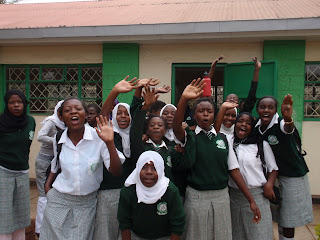Now that I have acquired the necessary resources (like textbooks), my students and I have gotten down to business. Due to the motivation of my students, I am able to do a lot with them. We are having large group tutoring sessions from 7 AM until 8AM every morning, and just about every student attends. Instead of forcing them to come, they show up willingly and express their appreciation with phrases like "May God bless you." This is completely opposite from teaching in Houston, where the students were sometimes adamant about not learning. On top of the morning sessions, we work for a half day, from 8 AM until noon, on Saturdays. Why so much teaching? I will tell you why. Try to solve this problem:
In the circle below, the triangle is an equilateral triangle of sides 7 cm. Find the area of the shaded part. Then, you want to fill the shaded part with paint. If the paint costs 39 shillings per square meter, find out how much the painting would cost.
This is an example of one of the questions on the freshman final math exam that they are expected to pass each year. If a student that finds it difficult to calculate the area of a circle is confronted with such a problem, the immediate reaction is to give up. If the problem above was an example of one of the hardest questions tested, it would be alright. However, their final exams are limited to only questions that are at this level. Furthermore, the end of the school year is in November, which means I only have two months before they are tested. Since my students are incredibly behind, they fully understand that it is business time.
Most of the questions in our textbooks are also at a similar difficulty level. Therefore, I typically write my own lessons with my own problems that are “scaffolded.” As you might assume, “scaffolded questions” are problems that start off fairly easy and then progress into more challenging ones. Since the school doesn’t have a copy machine, I use your donations to purchase my own copies of the guided examples for the students each day. Once I finish guiding the students through some of my example problems, I then let them go to the questions in their book. This is the same for math and English. However, I like to experiment with my teaching, so I often try to change up my lessons—which means this next week might be completely different.
Here are some pictures of the school:
Above is a picture of the students in their Friday morning assembly. The assistant principal is stating that the girls should be very thankful for their lunch, which consisted of a mixture of corn and beans called "Githeri." Note that the building looks fairly new--the government just gave the school money for needed renovations, although the government hasn't given us money for a sufficient amount of textbooks. Even if you are learning in a new building, it is difficult to learn how to read English if you don't have an English book to read.
Here, some of the students are leading the singing of the national anthem.
This is the Christian praise team leading some songs. The Christians lead the prayer on Friday, and the Muslims lead the prayer on Monday.
Here is a picture of some of my students during a break at Saturday school. Kenyans dress very professionally, especially the teachers, which is the reason why I have a tie on. Also, their uniforms may seem fancy, but all Kenyan schools require them and many of the students only have a couple pairs of the uniform.
These are some of my students outside of their classroom (the students stay in the same class all day, and the teachers come to them). I told them to wave to "America."
Here is a picture of me with the secretary and the person in charge of the school "strore." The store is where all of the books and other resources are kept, and the person that runs the store also has to keep records of the students.
The week before school started, I asked my friend Charles to give me a tour of Kibera, which is the largest slum in Africa (and it happens to be in Nairobi). Since it is the largest slum, the chairities and other NGO's have focused on it. Therefore, many of the residents in Kibera are very well taken care of, and many of them are self-sufficient since they have started their own businesses within the slum. The slum that many of my students come from, which is known as Majengo, is not like this: it is a very dangerous slum filled with prostitution and frequent violence. I will send pictures of Majengo later. For now, here is Kibera:
Above is Charles, who is a Franciscan brother who is still in formation.
Finally, I don't always teach--I need some time to relax! This is a picture of Joseph and I at a gospel concert. Joseph is one of the students that came with me to Mombasa, and I still hang out with him from time to time.











